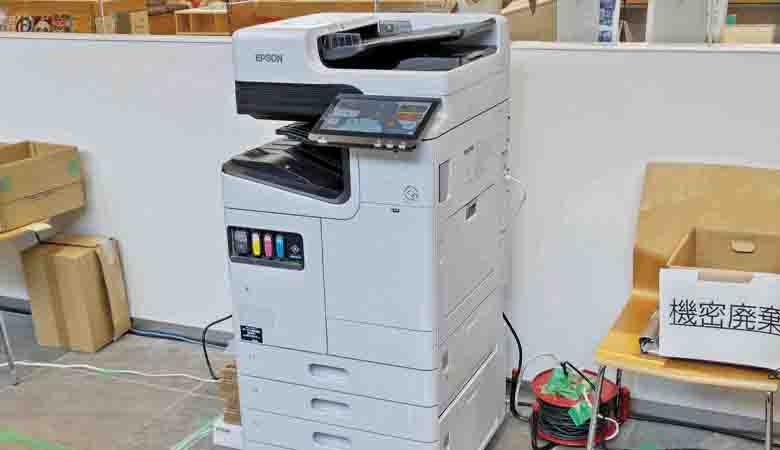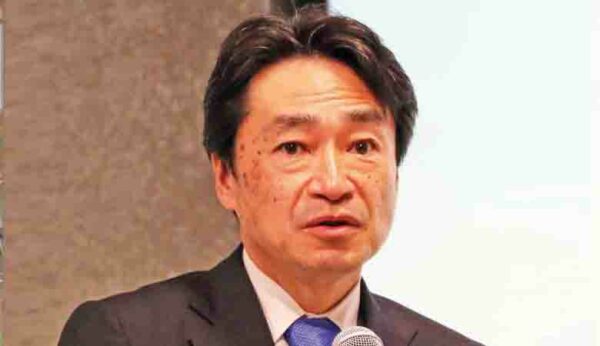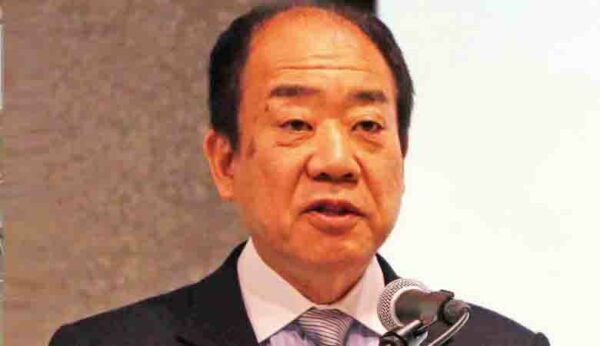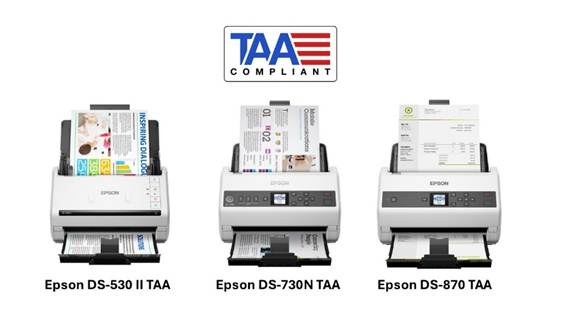The company’s recent update on its environmental initiatives included a preview of new technologies.
Above: Epson Group executives.
Seiko Epson, committed to addressing environmental issues through its Epson 25 Renewed and Environmental Vision 2050 initiatives, reflected on 2023 and shared its aspirations for the fiscal year 2024 during the Epson Group president’s press conference on March 12.
Epson President Yasunori Ogawa and Epson Sales President Fuminori Suzumura.
President Yasunori Ogawa discussed the development of unique technologies such as carbon-dioxide separation membrane technology and CO2 fixation technology using algae. He also revealed the global cumulative sales of Epson’s high-capacity ink tank inkjet printers had reached 90 million units as of December 2023. Fuminori Suzumura, president of Epson Sales, announced the provision of six energy-saving office inkjet multifunction printers to support areas affected by the Noto Peninsula earthquake and domestic sales efforts.
Epson 24 Renewed
Epson has been promoting its long-term vision, Epson 25 Renewed, since March 2021. This vision aims to co-create a sustainable and enriching society where people, objects, and information are interconnected through “sho-sho-sei [compact, precision, energy-saving] technology” and digital technology. As society moves from concentration to decentralization, the Epson Group is offering solutions that smartly connect people, objects, and information, contributing to the realization of their ideal condition across personal lives, industries, and manufacturing sites.
To realize this vision, Epson emphasizes the importance of the environment, digital transformation (DX), and co-creation. Environmental Vision 2050 aims to achieve carbon-negative and zero consumption of underground resources by 2050, striving for a sustainable and enriching society. Epson’s environmental efforts include decarbonization, resource circulation, reducing customers’ environmental impact, and developing environmental technologies.
Four Key Epson Initiatives
- DX Support – Epson is supporting its customers’ DX efforts. Education is one example where Epson Sales proposes using high-speed inkjet LX series multifunction devices and projectors to help improve teachers’ work environments and boost students’ motivation to learn. The LX series was introduced to approximately 5,600 educational institutions from April 2019 to February 2024, and about 130,000 projectors were being used by public and private schools from April 2019 to December 2023.
- Decarbonization – Epson is investing 100 billion yen between 2021 and 2030 in decarbonization efforts. All global Epson Group sites have switched to renewable energy for their electricity needs.
- Resource Circulation and Environmental Technology Development – Epson introduced a new lineup of its dry office papermaking machine, PaperLab. The A-8000 Refresh Model will be introduced in the spring of 2024, and a new PaperLab/shredder will be introduced in the fall. The company has also started constructing a metal refining plant in Hachinohe City, Aomori Prefecture, with an investment of 5.5 billion yen, targeting operation by June 2025.
- CO2 Removal Technologies – Aiming to be carbon negative by 2050, Epson is developing CO2 removal technologies, including CO2 separation membrane technology utilizing thin-film technology from inkjet heads to prioritize CO2 permeation and develop an efficient CO2 recovery system. Another focus is CO2 fixation technology using biotechnologies, concentrating on microalgae for more efficient CO2 fixation and resource utilization.
“We are advancing the development of technology that applies thin-film technology to separate CO2 from the air and transform it into something else,” said Ogawa. “In the case of algae, we are researching species with good CO2 absorption rates. While it will take some time, we are considering ways to transform CO2 into different materials.” As for the application, he noted, “Rather than creating large plants, we are considering making small portable ones. If we can develop something easily transported and, by arranging many of them together to absorb a lot of CO2, that would be ideal.”
Ogawa added that the fiscal year 2023 saw about 16 million inkjet printer units sold, with approximately 12.4 million being high-capacity ink tank models. Despite a decrease of about 1 million units in printer sales compared to the previous year, sales of high-capacity ink tank models remained consistent with previous years, highlighting their significance. The global cumulative sales of high-capacity ink tank models reached 90 million units in December 2023, since the launch of the first model, the L200, in October 2010.
Supporting Disaster-Affected Areas of Noto Peninsula

Smart Charge office MFP services at Suzu City Hall.
Suzumura revealed that as part of the support for the disaster-stricken areas of the Noto Peninsula, the company is lending energy-efficient office multifunction devices called Smart Charge to various municipalities in Ishikawa Prefecture. These devices are being used for creating and copying essential documents for administrative activities crucial for recovery, such as emergency communication with residents and disaster victim certificates. The devices have been installed at the Ishikawa Prefectural Office, Suzu City Hall, and Noto Town Office.
Output Environmental Assessments
The company is enhancing its Output Environment Assessment, which surveys and analyzes customers’ printing environments to propose improvements. Customers have widely adopted this service in the health care and welfare sectors. For example, a hospital with 200 to 300 beds replaced 535 laser printers with 489 inkjet printers following this assessment. This resulted in an approximately 8% reduction in the number of devices, an estimated 85% reduction in annual power consumption (from 41,538 kWh to 5,886 kWh), and an estimated 85% reduction in CO2 emissions (from 17,279 kg to 2,448 kg per year).
“With the current high electricity rates in the Tokyo Electric Power Company’s service area at 40 yen per kWh, the annual electricity cost for using laser printers would be about 1.6 million yen,” reported Suzumura. “By switching to inkjet, the cost is now about 250,000 yen. This scale becomes apparent when converted into electricity costs. For medical institutions, replacing printers every seven years can result in cost savings of about 10 million yen in electricity bills alone over that period.”
Sustainability Management
Epson Sales has initiated a Sustainability Management Promotion Support Service as an environmental assessment to support companies in specific decarbonization management. It is currently assisting over 40 companies. The company is also expanding its support services not only with inkjet multifunction devices but also by utilizing various decarbonization and energy-saving solutions that Epson offers.
To increase productivity, the company supports the automation of manufacturing processes in the food manufacturing industry, which is facing a severe labor shortage. Epson robots, capable of handling soft food without crushing it, are being used for tasks like food plating, sorting, and packaging of soft traditional sweets like Yatsuhashi.






